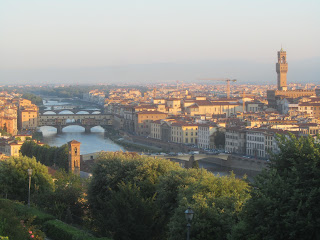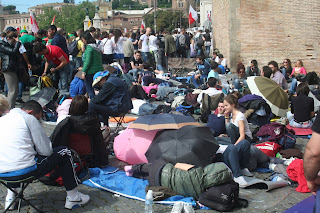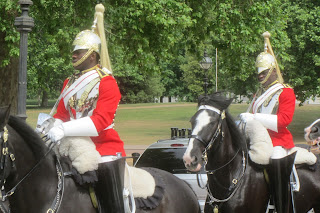It’s a holiday weekend over here, Tuesday being Republic
Day, commemorating the abolishment of the monarchy in 1946. From what I gather, it’s the biggest secular
holiday in Italy. Tuesday will also mark
my second month of residency here this time around.
I thought I would have had a few blog posts up by now but,
truth be told, I’ve been having a Dickens of a time getting something cogent on
paper. (I make no promises that this
will qualify but there’s been enough delay.)
I’m not entirely sure what the problem has been with that but
I have a few ideas.. When I moved here
in 2010 is was for what was to be a limited period of time . I had been fascinated by the city in some
prior visits and had always left thinking that it was a city that needed more
time, that there was so much more here than could be seen in a weekend or a
week or a month even.
So I moved here and it was just great and while it may have
become a bit more wonderful in memory than fact, the experience was stellar. So much newness, and when the time came to go
home, there was a tug between looking forward to getting on with life, whatever
that may be, and wanting to stay.
Still, shortly after I got back to the states, and I’m
talking days here, I was thinking of coming back. Rome had gotten its hooks in me as I suppose
any great city can do and after working a few years and saving up some funds, I
put just about everything back in storage and flew back.
Upon arrival, the darnedest thing happened. I didn’t exactly love it, although I wasn’t
quite sure why. There were some of the
usual irritants: The tourist crowds were intense. (I had, after all shown, up on Holy Thursday,
a busy time in a pilgrim city.) The
Roman every man (or woman) for his or herself attitude was jarring (more on
that at some later time). Then there was
the gauntlet of touts surrounding the major attractions and the ubiquitous and
determined selfie stick, rose, or shakalaka-boom-boom vendors. (For reasons that
I don’t understand, Roman street vendors tend to call anything that doesn’t
have a very specific name a shakalaka-boom-boom.)
So I suppose it’s possible that I’m just 4 years older and
crankier than I used to be but I don’t want to contemplate that
possibility. I think it was something
else. If I were writing from the states,
it would be appropriate to quote Thomas Wolfe.
You can’t go Rome again or something like that but this is the Mediterranean
so we’ll go with Heraclitus’ line the no man ever steps in the same stream
twice. It’s not the same river he’s not
the same man.
As mentioned, I suspect I’m somewhat different and, also, Rome
is different, at least a bit. Italy has
been in a financial crisis for the last three years and it extends to
Rome. There appears to be more poverty. There seems to be an increase in the working
poor. The streets are a mess, and the
sidewalks are worse (I’m thinking that maybe 70% of Roman dog owners clean up after their pooches).
There even seemed to be less water flowing from the city fountains. All that ‘s
true, again, at least a bit.
But even if the man and the stream were the same, the
relationship changes the second time around and I think that has a lot to do
with expectations and familiarity. Ever
go to a restaurant for the first time and order a dish you haven’t had before
and have it turn out to be spectacular? Ever
go back a month or so later, order it again and find it to be, well, just good?
I think there’s some of that at play. Also, as this is a return, there isn’t quite
the same joy of discovery. I don’t want to give the impression that I’ve seen
everything here, because I haven’t but that overwhelming rush of living in a
foreign country for the first time, well, that’s not going to happen again.
And there is something else and this may be the biggest
factor although one that I had forgotten until a conversation I had the other
night. Moving from one country to another takes some adjustment. It takes
awhile to settle in.
In the last week or so, it’s been starting to happen. I got out of Italy for a long weekend a
couple weeks ago. Coming back to Rome was,
in essence, coming back home and it felt like it (well, mostly).
Also, while I think I know the city pretty well, there are
plenty of new things to explore. Some
are archeological. A couple of quick
examples: Sometime in the last couple years and in the process of digging a new
subway route, workers discovered an auditorium form the time of the emperor
Hadrian (around 110 AD) Similarly, portions of Nero’s Domus Aurea (Golden
House), buried over shortly after his suicide (AD 68), are again open to the
public.
And then some of those events that are purely Roman have
been rolling around. Last Sunday,
Pentecost, I attended Mass in the Pantheon, consecrated as a church in
609. It’s a popular service. The pews and folding chairs are reserved for
the regular attendees and numerous ceremonial attendees (including the small
group that holds vigil at the tomb of the first modern king of Italy holding
out for a return to the monarchy.) There’s plenty of standing room but it fills
up pretty quickly. By 10, the Pantheon is full and they stop letting people
in. The service is a long one about an
hour and 45 minutes. It’s mostly in
Italian but even the English parts are unintelligible because of the room’s
echo. On the other hand, that echo makes
the choir and musicians sound great. All that’s well and good, but here’s the
cool part and the reason the place is packed.: During the last 20 minutes or
so, members of the Vigili Del Fuoco (basically the fire dept) scale the
building and at the start of the recessional drop tens of thousands of rose
petals through the oculus. It, of course
draws oohs and ahhs from the crowd and rightfully so. Who would want to be anywhere else?
We’re also enjoying a streak of spectacular weather. Warm breezy days and cool nights that are just
perfect for walking without agenda. The
other night I found a great little burger joint (ok, not so sure about putting a
slice of cucumber on the burger but they nailed the fries) in the Jewish Ghetto
of all places. Last night, I sat outside
the Pantheon a little after sundown, watching the sky take on a deep and vibrating
shade of blue that matches the lapis luzili that was so prized during the
renaissance. As a bonus, the clown/mime (more clown then mime) was back at work
in the piazza. Greeted at the outset by
pretty much universal indifference he managed over the next hour or so to amass
a large and appreciative crowd. There’s
a metaphor in there someplace.
So it’s a holiday weekend.
Tomorrow’s officially a work day but most of the Romans have left town
and, well, you know how that goes.
Tuesday there are parades and fireworks and flyovers but I’ll probably
skip those. On the other hand, June 2 is
the only day that the gardens in the Quirinale Palace are open to the public
and I shouldn’t miss that. Never seen
them before.
Oh, and Thursday the Pope processes through the
neighborhood.
It’s nice to be back.
I believe I can do this for a few more days.



















